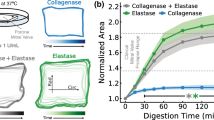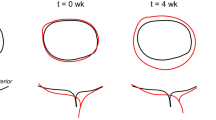Abstract
Regional heterogeneity in mitral annular contraction, which is generally ascribed to the fibrous vs. muscular annular composition, ensures proper leaflet motion and timing of coaptation. It is unknown whether the fibroblast-like cells in the annulus modulate this heterogeneity, even though valvular interstitial cells (VICs) can be mechanically “activated.” Fourteen sheep underwent implantation of radiopaque markers around the mitral annulus defining four segments: septal (SEPT), lateral (LAT), and anterior (ANT-C) and posterior (POST-C) commissures. Segmental annular contraction was calculated using biplane videofluoroscopy. Immunohistochemistry of annular cross sections assessed regional matrix content, matrix turnover, and cell phenotype. Micropipette aspiration measured the effective modulus of the leaflets adjacent to the myocardial border. Whereas SEPT contained more collagen I and III, LAT demonstrated more collagen and elastin turnover as shown by greater decorin, lysyl oxidase, and matrix metalloprotease (MMP)-13 and smooth muscle alpha-actin (SMaA). This greater matrix turnover paralleled greater annular contraction in LAT vs. SEPT (22.5 vs. 4.1%). Similarly, POST-C had more SMaA and MMP13 than ANT-C, consistent with greater annular contraction in POST-C (18.8 vs. 11.1%). Interestingly, POST-C had the greatest effective modulus, significantly higher than LAT. These data suggest that matrix turnover by activated VICs relates to annular motion heterogeneity, maintains steady-state mechanical properties in the annulus, and could be a therapeutic target when annular motion is impaired. Conversely, alterations in this heterogeneous annular contraction, whether through disease or secondary to ring annuloplasty, could disrupt this normal pattern of cell-mediated matrix remodeling and further adversely impact mitral valve function.





Similar content being viewed by others
References
Anderson, R., and B. Wilcox. The anatomy of the mitral valve. In: Mitral Valve Disease, edited by L. Shapiro. Oxford: Butterworth-Heinemann, 1996, pp. 4–13.
Balachandran, K., S. Konduri, P. Sucosky, H. Jo, and A. Yoganathan. An ex vivo study of the biological properties of porcine aortic valves in response to circumferential cyclic stretch. Ann. Biomed. Eng. 34:1655–1665, 2006.
Bothe, W., M. K. Rausch, J.-P. E. Kvitting, D. K. Echtner, M. Walther, N. B. Ingels, et al. How do annuloplasty rings affect mitral annular strains in the normal beating ovine heart? Circulation 126:S231–S238, 2012.
David, T. E., M. Komeda, C. Pollick, and R. J. Burns. Mitral valve annuloplasty: the effect of the type on left ventricular function. Ann. Thorac. Surg. 47:524–527, 1989.
Eckert, C. E., B. Zubiate, M. Vergnat, J. H. Gorman, R. C. Gorman, and M. S. Sacks. In vivo dynamic deformation of the mitral valve annulus. Ann. Biomed. Eng. 37:1757–1771, 2009.
Glasson, J. R., G. R. Green, J. F. Nistal, et al. Mitral annular size and shape in sheep with annuloplasty rings. J. Thorac. Cardiovasc. Surg. 117:302–309, 1999.
Glasson, J., M. Komeda, G. Daughters, et al. Three-dimensional regional dynamics of the normal mitral annulus during left ventricular ejection. J. Thorac. Cardiovasc. Surg. 111:574–585, 1996.
Green, G. R., P. Dagum, J. R. Glasson, et al. Restricted posterior leaflet motion after mitral ring annuloplasty. Ann. Thorac. Surg. 68:2100–2106, 1999.
Gunnal, S. A., M. S. Farooqui, and R. N. Wabale. Study of mitral valve in human cadaveric hearts. Heart Views 13:132–135, 2012.
Kaplan, S. R., G. Bashein, F. H. Sheehan, et al. Three-dimensional echocardiographic assessment of annular shape changes in the normal and regurgitant mitral valve. Am. Heart J. 139(3):378–387, 2000.
Karlsson, M., J. Glasson, A. Bolger, et al. Mitral valve opening in the ovine heart. Am. J. Physiol. 274:H552–H563, 1998.
Komoda, T., R. Hetzer, J. Oellinger, et al. Mitral annular flexibility. J. Cardiac. Surg. 12:102–109, 1997.
Krishnamurthy, V. K., F. Guilak, D. A. Narmoneva, and R. B. Hinton. Regional structure-function relationships in mouse aortic valve tissue. J. Biomech. 44:77–83, 2011.
Lansac, E., K. Lim, Y. Shomura, et al. Dynamic balance of the aortomitral junction. J. Thorac. Cardiovasc. Surg. 123:911–918, 2002.
Levack, M. M., A. S. Jassar, E. K. Shang, M. Vergnat, Y. J. Woo, M. A. Acker, et al. Three-dimensional echocardiographic analysis of mitral annular dynamics: implication for annuloplasty selection. Circulation 126:S183–S188, 2012.
Levine, R., J. Hung, Y. Otsuji, et al. Mechanistic insights into functional mitral regurgitation. Curr. Cardiol. Rep. 4:125–129, 2002.
Merryman, W. D., I. Youn, H. D. Lukoff, et al. Correlation between heart valve interstitial cell stiffness and transvalvular pressure: implications for collagen biosynthesis. Am. J. Physiol. 290:H224–H231, 2006.
Okada, Y., T. Shomura, Y. Yamaura, and J. Yoshikawa. Comparison of the Carpentier and Duran prosthetic rings used in mitral reconstruction. Ann. Thorac. Surg. 59:658–662, 1995.
Parish, L., B. Jackson, Y. Enomoto, R. Gorman, and J. Gorman, 3rd. The dynamic anterior mitral annulus. Ann. Thorac. Surg. 78:1248–1255, 2004.
Peyton, S. R., C. M. Ghajar, C. B. Khatiwala, and A. J. Putnam. The emergence of ECM mechanics and cytoskeletal tension as important regulators of cell function. Cell Biochem. Biophys. 47:300–320, 2007.
Rabkin-Aikawa, E., M. Farber, M. Aikawa, and F. J. Schoen. Dynamic and reversible changes of interstitial cell phenotype during remodeling of cardiac valves. J. Heart Valve Dis. 13:841–847, 2004.
Ranganathan, N., J. H. C. Lam, E. D. Wigle, and M. D. Silver. Morphology of the human mitral valve: II. The valve leaflets. Circulation 41:459–467, 1970.
Rausch, M. K., F. A. Tibayan, N. B. Ingels, D. C. Miller, and E. Kuhl. Mechanics of the mitral annulus in chronic ischemic cardiomyopathy. Ann. Biomed. Eng. 41:2171–2180, 2013.
Timek, T., P. Dagum, D. Lai, et al. Tachycardia-induced cardiomyopathy in the ovine heart: mitral annular dynamic three-dimensional geometry. J. Thorac. Cardiovasc. Surg. 125:315–324, 2003.
Timek, T. A., G. R. Green, F. A. Tibayan, et al. Aorto-mitral annular dynamics. Ann. Thorac. Surg. 76:1944–1950, 2003.
Tomasek, J. J., G. Gabbiani, B. Hinz, C. Chaponnier, and R. A. Brown. Myofibroblasts and mechano-regulation of connective tissue remodelling. Nat. Rev. Mol. Cell Biol. 3:349–363, 2002.
Tsakiris, A., G. Von Bernuth, G. Rastelli, M. Bourgeois, J. Titus, and E. Wood. Size and motion of the mitral valve annulus in anesthetized intact dogs. J. Appl. Physiol. 30:611–618, 1971.
van Rijk-Zwikker, G., B. Delemarre, and H. A. Huysmans. Mitral valve anatomy and morphology: relevance to mitral valve replacement and valve reconstruction. J. Cardiac. Surg. 9:255–261, 1994.
Walmsley, R. Anatomy of human mitral valve in adult cadaver and comparative anatomy of the valve. Br. Heart J. 40:351–366, 1978.
Wang, J., H. Chen, A. Seth, and C. A. McCulloch. Mechanical force regulation of myofibroblast differentiation in cardiac fibroblasts. Am. J. Physiol. 285:H1871–H1881, 2003.
Zhao, R., K. L. Sider, and C. A. Simmons. Measurement of layer-specific mechanical properties in multilayered biomaterials by micropipette aspiration. Acta Biomater. 7:1220–1227, 2001.
Acknowledgments
The authors appreciate assistance from Indrajit Nandi, the statistical expertise of Dr. Scott Baggett, and the micropipette aspiration equipment from Dr. Robert Raphael. Funding for this project came in part from graduate fellowships from the Hertz Foundation (EHS), National Institutes of Health (F30HL094019, EHS) and American Heart Association (PSC) and National Institutes of Health grants R01HL067025 and R01HL029589 (DCM).
Conflict of interest
Elizabeth H. Stephens was supported by individual graduate fellowships from the Hertz Foundation and NIH F30HL094019. Patrick S. Connell was supported by an individual fellowship from the American Heart Association. D. Craig Miller was supported by NIH R01 HL067025 and R01 HL029589. K. Jane Grande-Allen has served as a consultant for Edwards Lifesciences. Monica M. Fahrenholtz declares that she has no conflict of interest. Tomasz A. Timek declares that he has no conflict of interest. George T. Daughters declares that he has no conflict of interest. Joyce J. Kuo declares that she has no conflict of interest. Aaron M. Patton declares that he has no conflict of interest. Neil B. Ingels, Jr. declares that he has no conflict of interest.
Human Subjects Declaration
No human subjects studies were carried out by the authors for this article.
Animal Studies Declaration
The animal studies involved in this article were performed according to protocols approved by the Stanford University and Rice University Institutional Animal Care and Use Committees.
Author information
Authors and Affiliations
Corresponding author
Additional information
Associate Editor Ajit P. Yoganathan oversaw the review of this article.
Rights and permissions
About this article
Cite this article
Stephens, E.H., Fahrenholtz, M.M., Connell, P.S. et al. Cellular and Extracellular Matrix Basis for Heterogeneity in Mitral Annular Contraction. Cardiovasc Eng Tech 6, 151–159 (2015). https://doi.org/10.1007/s13239-014-0209-3
Received:
Accepted:
Published:
Issue Date:
DOI: https://doi.org/10.1007/s13239-014-0209-3




